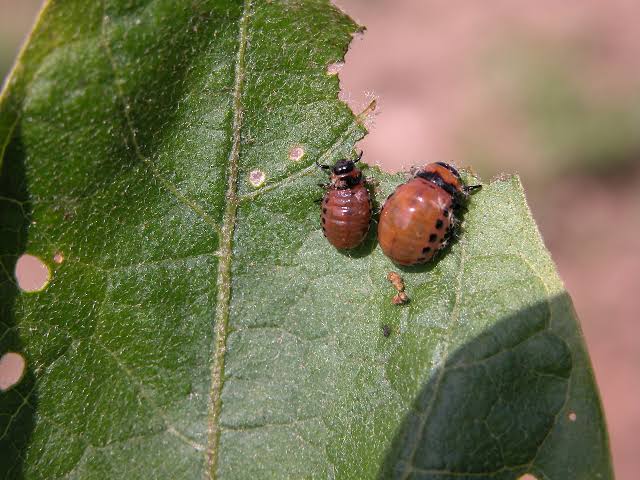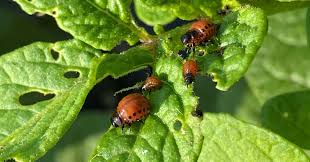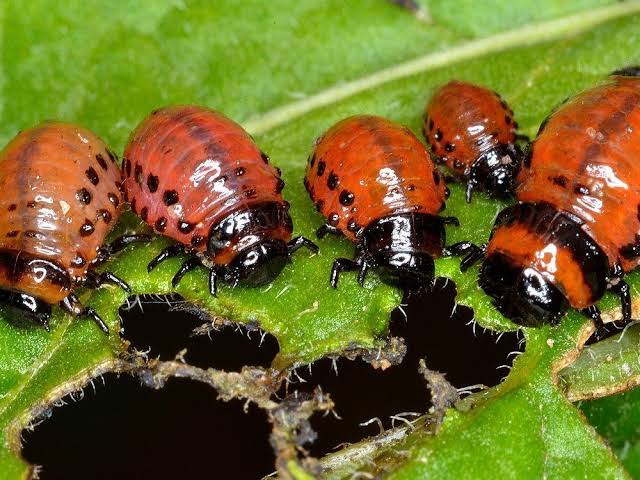The Colorado potato beetle, scientifically known as Leptinotarsa decemlineata, is a small insect that can cause big problems for potato farmers. This beetle is known for its bright yellow and black stripes, making it easily recognizable in potato fields. Let’s dive into the world of the Colorado potato beetle and explore its life, habits, and impact.
Colorado potato beetles have a life cycle that starts with eggs laid on the underside of potato leaves. These eggs hatch into larvae, which are hungry caterpillar-like creatures that devour potato plants with their voracious appetites. As they grow, the larvae go through several molts, shedding their skin to accommodate their increasing size.
The adult beetles emerge from pupae, ready to continue the cycle. These adults have a distinctive appearance, with a length of about half a centimeter and vibrant coloring. Their wings allow them to fly, which contributes to the spread of infestations from one field to another.
One of the challenges posed by the Colorado potato beetle is its ability to develop resistance to various pesticides over time. This resilience makes it a formidable adversary for farmers trying to protect their potato crops. As a result, researchers are continually exploring new ways to control these pests while minimizing the impact on the environment.
Farmers often implement integrated pest management strategies to keep Colorado potato beetles at bay. This approach may involve using natural predators, rotating crops, and employing biological controls to maintain a balance in the ecosystem. Additionally, the timing of planting and harvesting can play a role in managing beetle populations.
The economic impact of the Colorado potato beetle is significant, as infestations can lead to reduced potato yields and increased production costs for farmers. In regions where potato farming is a crucial industry, the presence of these beetles poses a serious threat to livelihoods.
The Colorado potato beetle, scientifically referred to as Leptinotarsa decemlineata, is a tiny but troublesome insect with a penchant for potato plants. Its life cycle, distinctive appearance, and ability to develop resistance to pesticides make it a challenging pest for farmers. Efforts to control these beetles involve a combination of methods, emphasizing sustainable and environmentally friendly practices to mitigate their impact on potato crops and agricultural economies.
Read Also: Tangerines: History, Nutrition, Health Benefits and Growing Guide
Plants Affected by Colorado Potato Beetle (Leptinotarsa decemlineata)

The Colorado potato beetle primarily targets plants belonging to the Solanaceae family. The most notable and economically significant plant affected by this beetle is the potato (Solanum tuberosum), from which the beetle derives its name. However, the Colorado potato beetle is not limited to potatoes alone.
Other plants within the Solanaceae family that can be affected by the Colorado potato beetle include:
1. Tomatoes (Solanum lycopersicum): These are another commonly cultivated crop susceptible to Colorado potato beetle infestations. The beetle can feed on tomato plants, causing damage to the leaves and potentially affecting fruit production.
2. Eggplants (Solanum melongena): Also known as aubergines, eggplants are part of the Solanaceae family and can fall victim to Colorado potato beetle feeding.
3. Bell Peppers (Capsicum annuum): Peppers, including bell peppers, are susceptible to damage from Colorado potato beetles. The beetles can consume the foliage, leading to reduced plant health and productivity.
4. Hot Peppers (Capsicum species): Varieties of hot peppers, such as chili peppers, can be affected as well. Colorado potato beetles may feed on the leaves, affecting the overall quality of the peppers.
While the primary focus is on potato crops due to the economic importance of potatoes, the ability of Colorado potato beetles to infest a variety of Solanaceous plants requires careful management strategies to protect multiple crops within this plant family. Farmers and researchers continually work on developing effective control measures to minimize the impact of Colorado potato beetles on these important agricultural crops.
Damages Caused by Colorado Potato Beetle

The Colorado potato beetle inflicts significant damage to crops, particularly potatoes, and other plants within the Solanaceae family. The damages caused by Colorado potato beetles include:
1. Defoliation: One of the most noticeable and harmful effects of Colorado potato beetle infestations is defoliation. The beetles, especially in their larval stage, consume the foliage of potato plants and other susceptible crops. This extensive feeding can lead to the loss of leaves, weakening the plants and reducing their ability to photosynthesize effectively.
2. Reduced Yield: The defoliation caused by Colorado potato beetles directly impacts the overall health and productivity of potato plants. With fewer leaves available for photosynthesis, the plants produce fewer carbohydrates, resulting in reduced tuber development and ultimately lowering the potato yield. This decline in yield can have significant economic implications for potato farmers.
3. Crop Quality: Beyond reducing yield, Colorado potato beetles can also compromise the quality of the harvested potatoes. Damage to the plants during their growth phase can result in misshapen or undersized tubers. Additionally, the presence of beetle feeding can lead to cosmetic blemishes on the potato skin, making them less visually appealing to consumers.
4. Transmission of Plant Diseases: Colorado potato beetles can act as vectors for certain plant diseases. As they feed on infected plants, they may pick up and transmit pathogens to healthy plants, contributing to the spread of diseases within potato and other Solanaceous crops.
5. Pesticide Resistance: The adaptability of Colorado potato beetles poses a unique challenge. Over time, populations of these beetles can develop resistance to various pesticides used for control. This resistance complicates pest management efforts and requires ongoing research to develop alternative strategies for effective control.
The cumulative impact of these damages not only affects individual farmers but can also have broader implications for regional and national agricultural economies where potatoes and related crops are significant commodities. Efforts to mitigate Colorado potato beetle damage often involve integrated pest management approaches, combining biological, cultural, and chemical control methods to sustainably address this persistent pest.
Read Also: Nectarines: History, Nutrition, Health Benefits and Growing Guide
Control and Preventive Measures

Controlling and preventing Colorado potato beetle infestations requires a multifaceted approach that combines various strategies to minimize the impact on crops. Here are some common control and preventive measures:
1. Crop Rotation: Rotate crops to disrupt the life cycle of Colorado potato beetles. Avoid planting potatoes or other Solanaceous crops in the same field year after year, as this can help reduce the buildup of beetle populations.
2. Early Planting and Harvesting: Time planting and harvesting to avoid peak beetle activity. Early planting may allow crops to establish before beetles become highly active, while early harvesting can help avoid extended exposure to late-season infestations.
3. Biological Control: Introduce natural predators and parasites that feed on Colorado potato beetles. Insect predators such as lady beetles, ground beetles, and parasitic wasps can help keep beetle populations in check. Encouraging a diverse ecosystem in and around fields can support natural enemies of the beetles.
4. Insecticidal Soaps and Oils: Use insecticidal soaps or oils as a less harmful alternative to chemical insecticides. These substances can disrupt the beetle’s respiratory system and provide effective control, especially during the early stages of infestation.
5. Neem Oil: Neem oil, derived from the neem tree, has insecticidal properties and can be used as a natural pesticide against Colorado potato beetles. It interferes with the beetles’ feeding and reproductive processes.
6. Pesticides: In cases of severe infestation, chemical pesticides may be necessary. However, it’s crucial to use these products judiciously to minimize environmental impact and prevent the development of pesticide resistance. Rotate between different classes of pesticides to reduce the risk of resistance.
7. Trap Crops: Plant trap crops, such as mustard or other Brassicaceae plants, to attract Colorado potato beetles away from main potato crops. This can help protect the primary crop by diverting the beetles to alternative host plants.
8. Monitoring and Early Detection: Regularly inspect fields for signs of Colorado potato beetle infestations. Early detection allows for prompt action, reducing the potential for extensive damage. Monitoring can involve visual inspections, pheromone traps, or using technology like remote sensing.
9. Cultural Practices: Implement cultural practices that create an environment less favorable for Colorado potato beetles. This may include proper spacing between plants, promoting good soil health, and maintaining weed control to reduce hiding places for beetles.
10. Resistant Varieties: Explore and plant potato varieties that exhibit resistance to Colorado potato beetles. Some potato cultivars have been bred to resist beetle feeding, providing an additional layer of defense.
Adopting an integrated pest management (IPM) approach that combines several of these strategies is often the most effective way to control Colorado potato beetles while minimizing the impact on the environment and promoting sustainable agriculture. Regular monitoring, adaptability, and a combination of preventive measures contribute to successful beetle management.
Frequently Asked Questions (FAQs) About Colorado Potato Beetle (Leptinotarsa decemlineata)
1. Q: What is the scientific name of the Colorado potato beetle?
A: The scientific name of the Colorado potato beetle is Leptinotarsa decemlineata.
2. Q: What plants are affected by the Colorado potato beetle?
A: The Colorado potato beetle primarily affects plants within the Solanaceae family, including potatoes, tomatoes, eggplants, bell peppers, and hot peppers.
3. Q: How does the Colorado potato beetle damage crops?
A: Colorado potato beetles cause damage by defoliating plants, reducing yield, affecting crop quality, acting as vectors for plant diseases, and potentially developing resistance to pesticides.
4. Q: How can farmers control Colorado potato beetle infestations?
A: Farmers can use various methods such as crop rotation, biological control with natural predators, early planting and harvesting, insecticidal soaps, neem oil, judicious pesticide use, trap crops, monitoring, cultural practices, and planting resistant varieties.
5. Q: Are there natural predators of the Colorado potato beetle?
A: Yes, natural predators include lady beetles, ground beetles, and parasitic wasps. Introducing these predators can help control Colorado potato beetle populations.
6. Q: Can Colorado potato beetles develop resistance to pesticides?
A: Yes, Colorado potato beetles have shown the ability to develop resistance to various pesticides over time, making it important to use integrated pest management strategies.
7. Q: What is integrated pest management (IPM)?
A: Integrated pest management is an approach that combines various strategies, including biological controls, cultural practices, and judicious pesticide use, to manage pests in a sustainable and environmentally friendly manner.
8. Q: Can Colorado potato beetles transmit plant diseases?
A: Yes, Colorado potato beetles can act as vectors for certain plant diseases. They may pick up and transmit pathogens as they feed on infected plants.
9. Q: Are there potato varieties resistant to Colorado potato beetles?
A: Yes, some potato varieties have been bred to exhibit resistance to Colorado potato beetles. Planting these resistant varieties can provide an additional layer of defense against infestations.
10. Q: How can farmers minimize the environmental impact of controlling Colorado potato beetles?
A: Farmers can minimize environmental impact by using integrated pest management practices, choosing environmentally friendly pesticides, and adopting sustainable farming practices that support natural pest control methods.
Read Also: How to Control Pests in the Garden






